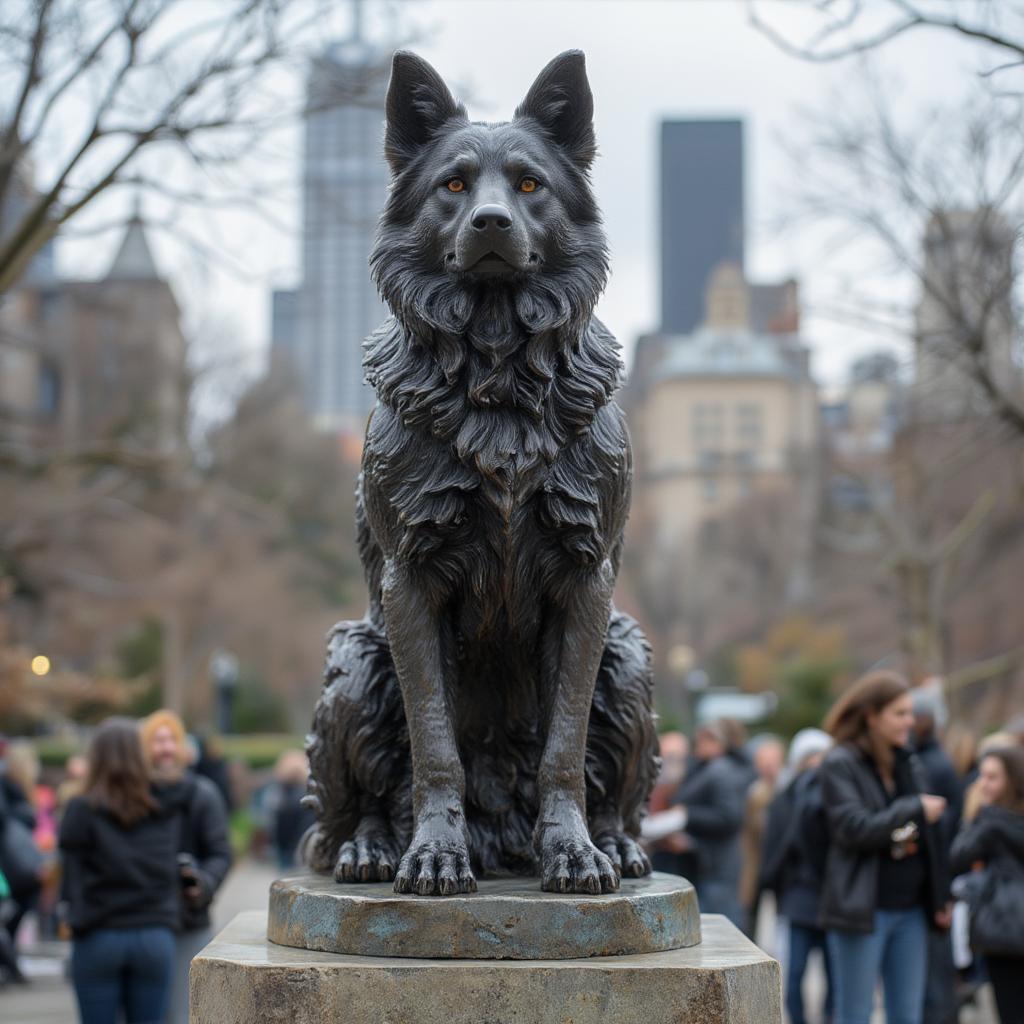Balto the Dog: The True Story of a Hero and His Legacy

Balto, a name synonymous with courage and resilience, is far more than just a character in an animated film. He’s a real-life hero, a Siberian Husky who played a crucial role in the 1925 serum run to Nome, Alaska. While the story often focuses on his final leg of the journey, understanding the complete tale reveals a more nuanced picture of this extraordinary dog and the real-life drama he was a part of.
The 1925 diphtheria outbreak in Nome posed a deadly threat to the town’s children. With no serum available and winter storms making air travel impossible, a relay of dog sled teams was organized to transport the life-saving medicine across nearly 700 miles of treacherous terrain. Balto’s team, led by driver Gunnar Kaasen, was the final team to make the trek into Nome. The image of Balto, covered in snow and pulling the sled, became an iconic symbol of the heroic effort. But was Balto truly the “hero” of the serum run? To fully appreciate Balto’s role, it’s important to delve deeper into the history and understand the contributions of all the dogs and mushers involved.
Understanding Balto’s Role in the Serum Run
The serum run, often dubbed the “Great Race of Mercy,” was not solely about one dog or one team. It was a collective effort, a relay race involving multiple teams of dogs and mushers, each covering a portion of the perilous route. What set Balto’s team apart was their crucial final leg, battling through a blinding blizzard in the dark of night. 
“It’s essential to remember that Balto was part of a larger team effort,” notes Dr. Emily Carter, a canine behavior specialist. “His contribution was significant, but the entire relay demonstrated the incredible strength and teamwork of dogs and humans working together.”
The conditions were brutal, with temperatures plummeting to well below zero and visibility near zero. The risk of getting lost or injured was extremely high. The team’s arrival in Nome with the life-saving serum was a monumental achievement, and Balto, being at the front of the team, became the face of that triumph. But the narrative surrounding his heroism was complex. While his final leg was impressive, the dogs on the teams before him also endured tremendous hardship and contributed significantly to the success of the mission.
The Complex Legacy of Balto
Following the serum run, Balto and his team became instant celebrities. They embarked on a national tour, drawing crowds and inspiring awe. The story of this brave sled dog captivated the public’s imagination, solidifying Balto’s place in history. However, the fame didn’t always translate into a comfortable life for Balto. The journey took its toll on him and his team. The adulation they received began to fade as another dog team and its lead dog, togo the dog story, eventually came to the forefront as a central part of the narrative.
One of the most significant outcomes of the serum run was the increased public awareness of the struggles of dogs, especially sled dogs, as working animals. Many of them were not given the best treatment, and they often suffered after their work was done. There was much conversation surrounding the proper care of dogs, which would lead to reforms in animal rights. In a way, the legacy of balto the dog who saved nome goes beyond his act of heroism.
Was Balto the Only Hero?
While Balto’s role in the final leg cannot be understated, it’s important to acknowledge the other dogs and mushers who played a pivotal part in the serum run. The lead dog on the longest stretch was, in fact, Togo, and the story of the bravest dog ever the true story of balto often gets a bit blurry when considering the contributions of other sled dogs, like Togo.
“The serum run was a collaborative effort, and every dog team contributed significantly to the success of the mission,” says Dr. David Miller, a veterinarian with expertise in canine history. “It’s essential to remember and appreciate the combined heroism of all the dogs involved.”
The true story is that Balto was only the last team on the relay, and the trip would not have been possible if not for all of the teams that participated. It is interesting to note the the dog actually led the team the longest distance was Togo, who traveled over 200 miles through some of the harshest terrain. It is fair to say that while Balto did do his part, perhaps history has been a little unfair to Togo.
What is the Difference Between Balto the Film and Balto in Real Life?
The animated film “Balto,” while inspired by true events, takes many liberties with the actual story. The film often portrays Balto as a wolf-dog outcast, whereas in reality, he was a Siberian Husky. While a lot of the movie is based on factual events, some is simply the writer taking creative liberties.

Another key difference is the focus on Balto as the sole hero. As we’ve discussed, the serum run was a team effort with multiple teams and dogs involved. The film often omits or downplays the contributions of other dogs, like Togo, and teams. The animated movie is designed to engage and entertain, but the facts are a bit different than Hollywood sometimes portrays.
Balto’s Continuing Influence
Even today, Balto’s legacy continues to inspire and fascinate. The image of the brave sled dog, leading the team to save a town, remains a powerful symbol of courage and determination. His story has been passed down to future generations and serves as a testament to the incredible bond between humans and animals. He is a reminder of the power of teamwork and the importance of perseverance in the face of adversity.
The bronze statue of Balto in Central Park in New York City stands as a lasting tribute to his heroic contributions. It serves as a constant reminder of the power of courage, especially the courage of animals. People still visit and leave tributes to the hero dog. His story reminds us that a single act of bravery can have a lasting impact. 
“Balto’s enduring popularity speaks to the power of a good story,” states Sarah Johnson, an expert in animal history. “His story captures the imagination and reminds us of the incredible connection between humans and animals.”
Where Can I Learn More About Balto and the Serum Run?
There are many ways to learn more about balto real life and the serum run. You can visit museums and historical societies in Alaska, which are likely to have exhibits dedicated to the event. There are also many reputable books and documentaries that provide detailed accounts of the run. You can delve into the stories of all the dogs, not just Balto, and gain a broader perspective on their contributions. You may be surprised to see how much the animated movie left out.
It is also important to recognize the stories of the other heroes of the serum run. Learning about Togo, for example, will add more depth and nuance to your understanding of the events. You can also compare the facts to the fictional account.
Conclusion: The Enduring Story of a Heroic Dog
Balto’s story transcends the simple narrative of a single heroic dog. It’s a story about a community banding together in the face of a devastating outbreak, a testament to the courage and resilience of the sled dogs and mushers, and an inspiring reminder of the human-animal bond. While the spotlight often shines on Balto, remembering the complete story of the 1925 serum run highlights the importance of acknowledging all who contributed to this heroic feat. The real story of balto real dog is so much more interesting than the movie, and so much more important. Ultimately, Balto’s legacy will endure as a symbol of courage and teamwork.
Frequently Asked Questions About Balto
1. Was Balto the only dog who ran in the serum run?
No, Balto was one of many dogs who participated in the serum run. It was a relay, and many teams of dogs and their mushers ran different segments of the journey to get the life-saving diphtheria antitoxin to Nome.
2. What breed of dog was Balto?
Balto was a Siberian Husky, a breed known for its endurance and ability to thrive in cold conditions. He is often confused with a wolf-dog hybrid in popular culture.
3. Was Balto’s team the only hero?
No, the serum run was a collaborative effort. Balto’s team was the last team on the relay, but the teams before them also faced significant challenges and hardship.
4. How accurate was the “Balto” movie?
The animated movie “Balto,” while inspired by the true story, took many creative liberties. The film’s portrayal of Balto is fictionalized and does not accurately depict the actual events.
5. What is the significance of the Balto statue in Central Park?
The statue is a memorial to Balto and the other dogs of the serum run. It serves as a constant reminder of their bravery and dedication.
6. Where can I see Balto’s body?
Balto’s body was preserved and is on display at the Cleveland Museum of Natural History. You can visit this unique tribute to the hero dog if you have the opportunity.
7. Was Togo a more important dog in the serum run?
Togo is considered by many to have played the biggest role in the serum run, and is considered to have been the lead dog on the longest leg of the journey. Many believe that he and his driver were the true heroes of the event.




